Her Majesty’s Prison and Probation Service workforce quarterly: December 2021
Published 17 February 2022
Applies to England and Wales
Main Points
| 58,182 staff in post FTE (full time equivalent) | This is an increase of 7,997 FTE (15.9%) staff in post since 31 December 2020 and a minimal change of 16 FTE (0.0%) since 30 September 2021. This includes over 7,000 staff transferred from the Private Sector Community Rehabilitation Companies (CRCs) in June 2021. Of the staff in post, there were 34,267 FTE in Public Sector Prisons (PSP), 16,495 FTE staff in the Probation Service, 5,872 FTE staff in HQ and Area Services, and 1,548 FTE in the Youth Custody Service (YCS). |
| 22,156 FTE band 3-5 prison officers in post | This is an increase of 592 FTE (2.7%) since 31 December 2020 and a slight decrease of 169 FTE (0.8%) prison officers compared to 30 September 2021. |
| 5,002 FTE band 2 operational support staff in post | This is an increase of 102 FTE (2.1%) since 31 December 2020 and a slight decrease of 101 FTE (2.0%) operational support staff since 30 September 2021. |
| 4,490 FTE band 4 probation officers in post | This is an increase of 835 FTE (22.8%) since 31 December 2020 and an increase of 202 FTE (4.7%) compared to 30 September 2021. In addition to the band 4 probation officers, there were 5,739 FTE band 3 probation services officers: an increase of 3,064 FTE (114.5%) since 31 December 2020 and no substantial change since 30 September 2021. This has mainly been caused by the transfer of CRC staff in June 2021. |
| Leaving rate of 12.6% amongst band 3-5 prison officers | This is an increase of 3.4 percentage points compared to the year ending 31 March 2021. The overall leaving rate across HMPPS over the past 12 months stood at 11.2%, which is an increase of 2.8 percentage points compared to the year ending 31 March 2021. |
This publication provides details of staffing levels, staff inflows and outflows, sickness absence rates, and protected characteristics for the directly employed workforce of HMPPS. Information presented covers PSP, the Probation Service, the YCS, and HMPPS headquarters, which includes Area Services that provide direct operational support to prisons. Technical details and explanatory notes can be found in the accompanying Guide to HM Prison and Probation (HMPPS) Workforce Statistics.
Statistician’s comment
The number of HMPPS staff in post remains broadly unchanged to the previous quarter but is 15.9% higher than December 2020. This is due to the transfer of over 7,000 staff from the Private Sector Community Rehabilitation Companies (CRCs) in June 2021.
Leaving rates for HMPPS stood at 11.2% over the past 12 months to December 2021. Leaving rates fell during the COVID-19 pandemic, possibly due to uncertainty in the employment market. The latest figures show leaving rates are higher than pre-pandemic levels (10.5% for 12 months to 31 March 2020) and are the highest in the time series.
HMPPS staff lost an average of 13.0 working days to sickness absence in the 12 months ending 31 December 2021 (including COVID sickness), this is almost three working days higher than pre-pandemic levels. The latest figures show YCS had the highest sickness absence rate and HQ and Areas services had the lowest sickness absence rate. The main reason for sickness within HMPPS was mental and behavioural disorders (29.6% of absences) followed by Epidemic/Pandemic (23.9%).
Points to note
Her Majesty’s Prison and Probation Service
Her Majesty’s Prison and Probation Service (HMPPS) is focused on supporting operational delivery and the effective running of prison and probation services across the public and private sectors. HMPPS works with a number of partners to carry out the sentences given by the courts, either in custody or the community. This publication covers the reporting period up to 31 December 2021 and therefore considers in detail quarterly staffing levels and staff inflows and outflows, for HMPPS and its predecessors, since 2016.
For ease, the statistics in this publication will be referred to as those of the HMPPS workforce (i.e. staff working in HMPPS and with a contract of employment with HMPPS, excluding those on career breaks and those on secondment or loan outside of HMPPS but including staff on secondment or loan into HMPPS). In April 2017, the Youth Custody Service (YCS) was launched and forms another distinct arm of HMPPS. In terms of how these particular staffing figures appear in the statistics, central YCS units are categorised within HQ and Area Services whilst the Youth Custody Estate element of the YCS category is included separately in the publication tables. This covers staffing figures for Cookham Wood, Feltham, Werrington, and Wetherby Youth Offending Institutions (YOIs) as well as Medway Secure Training Centre (STC), which closed on 31 March 2020. Historical and latest figures for the Youth Custody Estate have been separated out to allow comparisons to be made and to establish the trends over time for these YOIs and Medway STC.
Further information on the introduction of the YCS and other major organisational changes is provided in the accompanying Guide to Workforce Statistics. Only staff in PSP, YCS, HMPPS HQ and Area Services, as well as the Probation Service, are directly employed by HMPPS and therefore staffing in private sector establishments, community rehabilitation companies and other contractors are excluded.
Coronavirus (COVID-19)
Figures relating to effect of the coronavirus (COVID-19) on HMPPS staff are published alongside this edition of the bulletin as a separate annex. They are experimental statistics and include information about COVID related testing, sickness and deaths of HMPPS staff.
Annex on Prison Officer recruitment diversity
As noted in previous bulletins, the annex with experimental statistics on Prison Officer and Operational Support Grade (OSG) recruitment has been moved to a six-monthly production cycle.
Annex on Probation Officer Vacancies and Trainees
As of the June 2019 publication, an experimental statistics annex has been added to this bulletin which presents figures on Probation Officers in post, and their required staffing level, in addition to the number of trainee and qualified Probation Officers.
Recent Organisational Changes
-
In late June 2021, more than 7,000 staff from private sector Community Rehabilitation Companies (CRC) came together with probation staff already in the public sector in the new Probation Service.
-
From April 2021 the Probation Service has been undergoing a reorganisation, with staff moving into new Probation Delivery Units (PDUs). As staff movement is ongoing we have only published staffing data at the regional level in Table 16 of the accompanying tables.
-
Medway Secure Training Centre closed on 31 March 2020.
Future Plans
For future publications we are considering ways in which we can improve the bulletin, and some of the issues we may look into are as follows:
- How to make the tables and presentation of the figures more user-friendly.
- Whether to and how to expand the range of information provided.
If you have any particular comments or views on the above, or any other aspects you would like to be considered about this bulletin, please contact us at the address given at the end of the publication.
1. Total HMPPS staff in post
58,182 full time equivalent (FTE) staff in post (as at 31 December 2021)
This is an increase of 7,997 FTE (15.9%) staff in post since 31 December 2020 and a minimal change of 16 FTE (0.0%) since 30 September 2021 driven mainly by the transfer of CRC personnel into HMPPS. Of the staff in post, there were 34,267 FTE in Public Sector Prisons (PSP), 16,495 FTE staff in the Probation Service, 5,872 FTE staff in HQ and Area Services, and 1,548 FTE in the Youth Custody Service (YCS).
As at 31 December 2021, there were 58,182 FTE staff in post in HMPPS on a full time equivalent (FTE) basis (Figure 1). This includes 34,267 FTE staff in PSP (making up 58.9% of all HMPPS staff), 16,495 FTE in the Probation Service (28.4% of all HMPPS staff), 5,872 FTE in HMPPS HQ and Area Services (10.1% of all HMPPS staff), and 1,548 FTE in the YCS (2.7% of all HMPPS staff).
Compared to 31 December 2020, the overall staff numbers increased by 7,997 FTE (15.9%): FTE in PSP slightly increased by 526 (1.6%), FTE in the Probation Service increased by 6,962 (73.0%), FTE in HQ and Area Services increased by 474 (8.8%), and FTE in the YCS increased by 36 (2.4%). These changes are affected by the organisational changes described above, such as move of over 7,000 staff from Private Sector CRCs into the Probation Service in June 2021.
As at 31 December 2021, there were 28,155 FTE (48.4% of HMPPS staff) operational prison service staff (including YCS staff). This is an increase of 712 FTE staff (2.6%) compared to 31 December 2020. Non-operational roles across PSP, YCS, and HMPPS HQ accounted for 12,354 FTE staff (21.2% of HMPPS staff), which is an increase of 365 FTE (3.0%) since 31 December 2020. There were 17,673 FTE staff[footnote 1] in the Probation Service (30.4% of all HMPPS staff): an increase of 6,920 (64.4%) FTE since 31 December 2020.
For the CRC staff that moved to the Probation Service in June 2021 some staff have been classified as ‘unknown’ grade in the accompanying tables. In addition, declaration rates (as in table 5d) initially dropping in June 2021 following CRC staff moving to the Probation Service, these have now started to increase as staff have updated their voluntary declarations on diversity information.
Figure 1: Number of HMPPS staff in post on an FTE basis, 31 March 2016 to 31 December 2021 (Source: Table 1)

1.1 Length of Service
Length of service information has been calculated for HMPPS staff from the most recent hire date. Where staff have transferred in from another government department or have transferred in through HMPPS taking over a function, length of service is calculated from entry to HMPPS.
Across HMPPS overall, 27.1% of FTE staff in post had less than 3 years’ service, which was a decrease from 29.9% at 31 December 2020 and a slight decrease from 27.6% at 30 September 2021. 34.5% of HMPPS FTE staff in post had 10 years or more of experience, representing a decrease from 36.8% at 31 December 2020 and a slight decrease from 35.1% at 30 September 2021.
It should be noted, that the National Probation Service was created on 1 June 2014 and the service of Probation Service staff in Probation Trusts prior to the creation of the Probation Service is not included. Therefore, the figures relating to the length of service of Probation Service staff, which are included in the HMPPS overall figures, do not necessarily represent their full experience but rather the length of service from entry to HMPPS. The situation is different for the over 7000 staff who transferred from the CRCs in June 2021 and for them their service prior to their date of transfer is included.
Excluding the Probation Service, 26.5% of FTE staff in post across HMPPS had less than 3 years’ service as at 31 December 2021. This is a decrease of 4.1 percentage points compared to 31 December 2020. The non-Probation Service staff with 10 years’ experience or more made up 41.2% of the workforce, which is a 3.7 percentage points decrease compared to 31 December 2020.
2. Band 3-5 prison officers and band 2 operational support staff
22,156 FTE band 3-5 prison officers in post (as at 31 December 2021)
This is an increase of 592 FTE (2.7%) FTE since 31 December 2020 and a slight decrease of 169 FTE (0.8%) prison officers compared to 30 September 2021.
5,002 FTE band 2 operational support staff in post (as at 31 December 2021)
This corresponds to an increase of 102 FTE (2.1%) since 31 December 2020 and a slight decrease of 101 FTE (2.0%) operational support staff since 30 September 2021.
The key operational grades in public sector prisons are the band 3 to 5 prison officers. They consist of band 3 prison officers, band 4 officer specialists, band 4 supervising officers, and band 5 custodial managers.
As at 31 December 2021, there were 22,156 FTE band 3 to 5 officers, which is an increase of 592 FTE (2.7%) compared to 31 December 2020 and a slight decrease of 169 FTE (0.8%) prison officers since the previous quarter (Figure 2).
The number of band 2 operational support grade (OSG) FTE staff increased by 102 FTE (2.1%) against the previous year and slightly decreased by 101 FTE (2.0%) compared to the previous quarter, to stand at 5,002 for 31 December 2021.
Figure 2: Number of band 3-5 prison officers in post on an FTE basis, 31 March 2016 to 31 December 2021 (Source: Table 3)

The proportion of band 3-5 prison officers with less than 3 years’ service at 31 December 2021 fell to 28.9% compared to 34.6% as at 31 December 2020. The proportion of officers in post with 10 years or more of experience decreased by 4.5 percentage points from 41.9% at 31 December 2020 to 37.4% at 31 December 2021. This corresponds to 8,279 FTE staff with 10 years or more of experience at 31 December 2021, which is a fall of 753 FTE, or 8.3% since 31 December 2020.
The proportion of band 2 OSG FTE staff with less than 3 years’ service slightly increased from 38.0% at 31 December 2020 to 39.1% at 31 December 2021, and the proportion of those with 10 years or more of experience decreased from 41.6% at 31 December 2020 to 36.8% at 31 December 2021.
Figure 3 shows a quarterly trend of band 3 to 5 appointments and leavers since 2015/16. Over the year to 31 December 2021, 4,132 band 3 to 5 officers were appointed (consisting of direct new recruits and existing staff who converted to a band 3 officer grade), an increase of 1,782 (75.8%) compared to 2,350 in the previous year. Looking at the quarterly figures, the headcount of new band 3 to 5 officer appointments decreased by 272 (22.0%) from 1,238 between July and September 2021 to 966 between October and December 2021 (Table 17).
The headcount of band 3 to 5 prison officers who left HMPPS in the year ending 31 December 2021 was 2,931, which is an increase of 723 (32.7%) compared to the year ending 31 December 2020. Examining reasons for leaving, 70.1% of prison officers who left in the year ending 31 December 2021 resigned from their roles (up from 61.4% in the year ending 31 December 2020). Of the other prison officers who left HMPPS, 12.0% were dismissed and 8.0% retired in the year ending 31 December 2021: the numbers dismissed are down from 14.7% compared to previous year while the number retiring are up from 10.0%.
Figure 3: Newly appointed band 3 to 5 prison officers and band 3 to 5 prison officer leavers, April 2015 to 31 December 2021 (Source: Table 17)
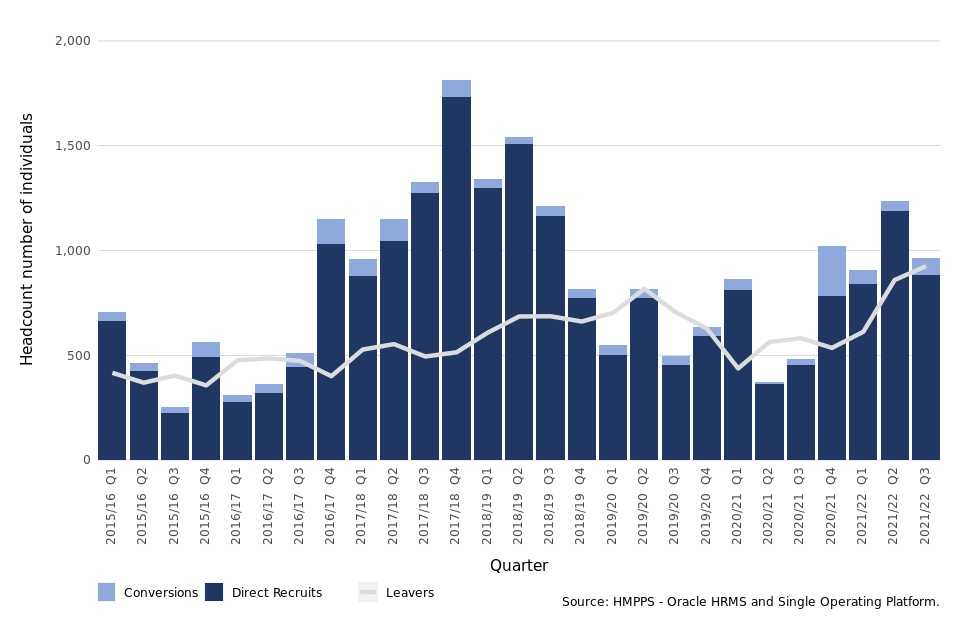
The number of band 2 OSG staff who joined HMPPS in the year ending 31 December 2021 was 1,435: an increase of 539 (60.2%) compared to the previous year ending 31 December 2020. There was an increase of 39 (2.8%) since the year ending 30 September 2021. The headcount number of band 2 OSG staff who left HMPPS was 864, which is an increase of 270 (45.5%) compared to the year ending 31 December 2020 and an increase of 96 (12.5%) compared to the year ending 30 September 2021.
Joiners and leavers are not the only movements into and out of the band 3 to 5 officer grouping. There are also typically differences in the proportion of new joiners and older officers who work part time as well as movements between grades. For these reasons, the change in FTE does not directly reflect the difference between the number of joiners and leavers. Changes such as staff switching from full time to part time have the effect of reducing the FTE of officers available as they progress through their career.
3. Probation practitioners and senior probation officers
4,490 FTE band 4 probation officers in post (as at 31 December 2021)
This figure is an increase of 835 FTE (22.8%) since 31 December 2020 and an increase of 202 FTE (4.7%) probation officers compared to 30 September 2021. In addition to the band 4 probation officers, there were 5,739 FTE band 3 probation services officers: an increase of 3,064 FTE (114.5%) since 31 December 2020 and no substantial change since 30 September 2021 which would have been driven by the transfer of ex-CRC staff into the public sector in June 2021.
Key grades in the Probation Service include band 3 probation services officers, band 4 probation officers (collectively known as probation practitioners), as well as band 5 senior probation officers. Staff who are training to be a probation officer work as a probation services officer during their training, so a proportion of the probation services officers in post will be working towards the professional probation officer qualification.
As of the June 2019 publication, an experimental statistics annex has been added to this bulletin which presents figures on Probation Officers in post, their required staffing level, in addition to the number of trainee and qualified Probation Officers.
In late June 2021, more than 7,000 staff from private sector CRCs came together with probation staff already in the public sector in the new Probation Service. These staff are being treated as transfers in and will not be counted as new joiners. Processing of these staff into the HMPPS organisation is still ongoing with some yet to be allocated grades or to a PDU.
As at 31 December 2021 there were 5,739 FTE band 3 probation services officers in post, an increase of 3,064 FTE (114.5%) over the past year and no substantial change over the quarter; 4,490 FTE band 4 probation officers, representing an increase of 835 FTE (22.8%) over the past year and an increase of 202 FTE (4.7%) compared to the previous quarter; and 1,218 FTE band 5 senior probation officers, showing an increase of 380 (45.3%) over the previous year and no substantial change since the last quarter (Figure 4). These increases have been driven by the introduction of ex-CRC staff back into the public sector in June 2021.
Figure 4: Number of probation officers, probation services officers and senior probation officers in post on an FTE basis, 31 March 2016 to 31 December 2021 (Source: Table 3)
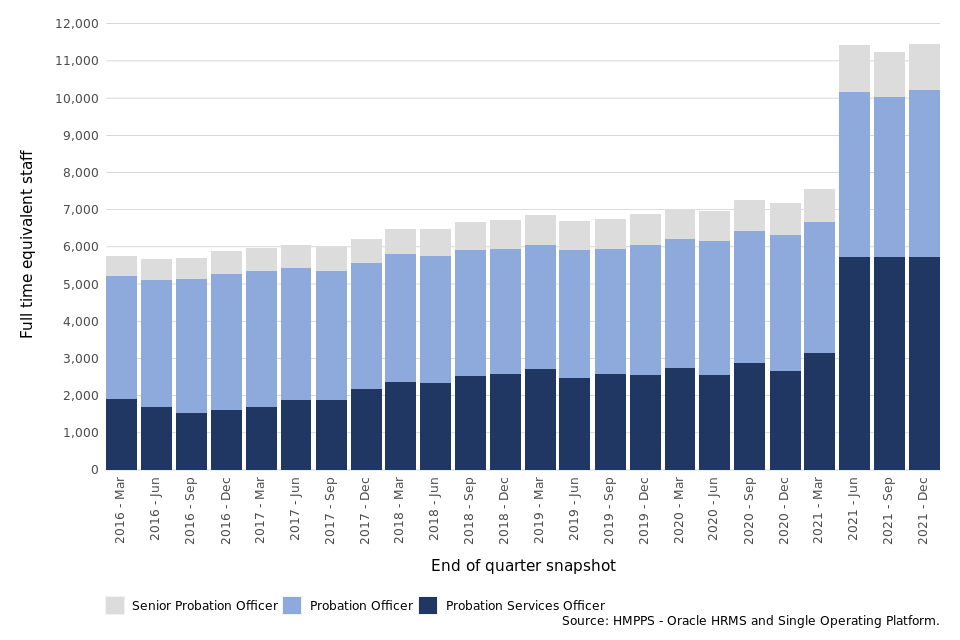
In the past year, 1,177 probation services officers were appointed, some of whom will be training to become qualified probation officers. This is an increase of 554 (88.9%) compared to the year ending 31 December 2020 and an increase of 400 (51.5%) compared to the number appointed in the year ending 30 September 2021, which may reflect the PQiP recruitment drive ahead of Probation unification during 2021. This recruitment drive aimed to recruit 1,000 probation officers in total for 2020/21, and in the 12 months to March 2021, 1,007 trainees started training, consisting of both external and internal candidates (please refer to the Probation recruitment annex for more details). In the past year, 554 probation services officers left the service. This is an increase of 340 (158.9%) compared to the year ending 31 December 2020 and an increase of 171 (44.6%) compared to the number who left in the year ending 30 September 2021.
4. Joiners and Leavers
Leaving rate of 12.6% amongst band 3-5 prison officers (for the 12 months ending 31 December 2021)
This is an increase of 3.4 percentage points compared to the year ending 31 March 2021. The overall leaving rate across HMPPS over the past year stood at 11.2%, which is an increase of 2.8 percentage points compared to the year ending 31 March 2021.
Over the past year, 7,983 staff joined HMPPS, which is an increase of 2,904 (57.2%) compared to the year ending 31 December 2020. These joiners consisted of 5,563 across PSP, 261 in the YCS, 1,645 in the Probation Service, and 514 in HMPPS HQ and Area Services. Compared to the year ending 31 December 2020 these numbers of joiners represent an increase of 55.2% for PSP, an increase of 135.1% for YCS, an increase of 72.1% for Probation Service, and an increase of 20.1% for HMPPS HQ and Area Services.
There were 6,701 leavers in the year ending 31 December 2021, an increase of 2,085 (45.2%) compared to the year ending 31 December 2020. This includes 4,676 leavers from PSP (an increase of 34.9%), 166 from YCS (an increase of 23.9%), 1,424 from the Probation Service (an increase of 116.7%), and 435 from HMPPS HQ and Area Services (an increase of 22.9%).
4.1 Leaving Rates[footnote 2]
The overall HMPPS leaving rate for the year to 31 December 2021 was 11.2%, compared to 8.3% for the year to 31 March 2021 (Figure 5). For the year up to 31 March 2021 the increased uncertainty in the employment market following the COVID-19 pandemic may have contributed to the drop in the number of resignations during most of the year, thus impacting on the overall reduced leaving and resignation rates. Leaving rates are now higher than levels seen prior to the pandemic. Specifically for band 3 to 5 prison officers, the leaving rate of 12.6% in the year ending 31 December 2021 represented an increase of 3.4 percentage points since the year ending 31 March 2021. The leaving rate for band 2 OSG staff was 16.2% in the year ending 31 December 2021, which is an increase of 4.3 percentage points compared to the year ending 31 March 2021.
Figure 5: Annual leaving rates of permanent staff in key operational grades (excluding VEDSR), from the 12 months to 31 March 2016 to the 12 months to 31 December 2021 (Source: Table 11)
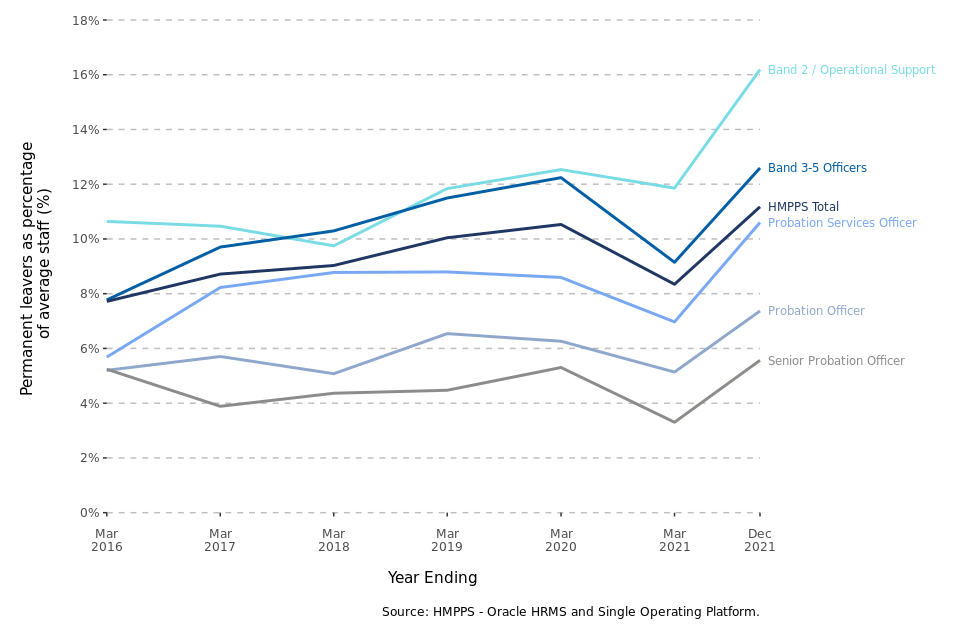
4.2 Resignation Rates[footnote 3]
The overall HMPPS resignation rate for the 12 months to 31 December 2021 was 7.4%, compared to 4.5% for the year to 31 March 2021 (Figure 6). Specifically for band 3-5 officers, the resignation rate was 8.9% in the year ending 31 December 2021, which is an increase of 3.5 percentage points since the year ending 31 March 2021. The resignation rate for OSG staff was 11.0% for the year ending 31 December 2021, which is an increase of 4.4 percentage points since the year ending 31 March 2021.
For Probation Service overall, the resignation rate was 6.0% for the year ending 31 December 2021. This represents an increase of 2.8 percentage points compared to the year ending 31 March 2021. Amongst the operational grades within the Probation Service, probation services officers had the highest resignation rate at 8.2%, (an increase of 3.8 percentage points) since the year ending 31 March 2021. Resignation rates for probation officers stood at 4.5% (a slight increase of 1.8 percentage points) since the year ending 31 March 2021).
Figure 6: Annual resignation rates of permanent staff in key operational grades, from the 12 months to 31 March 2016 to the 12 months to 31 December 2021 (Source: Table 12)
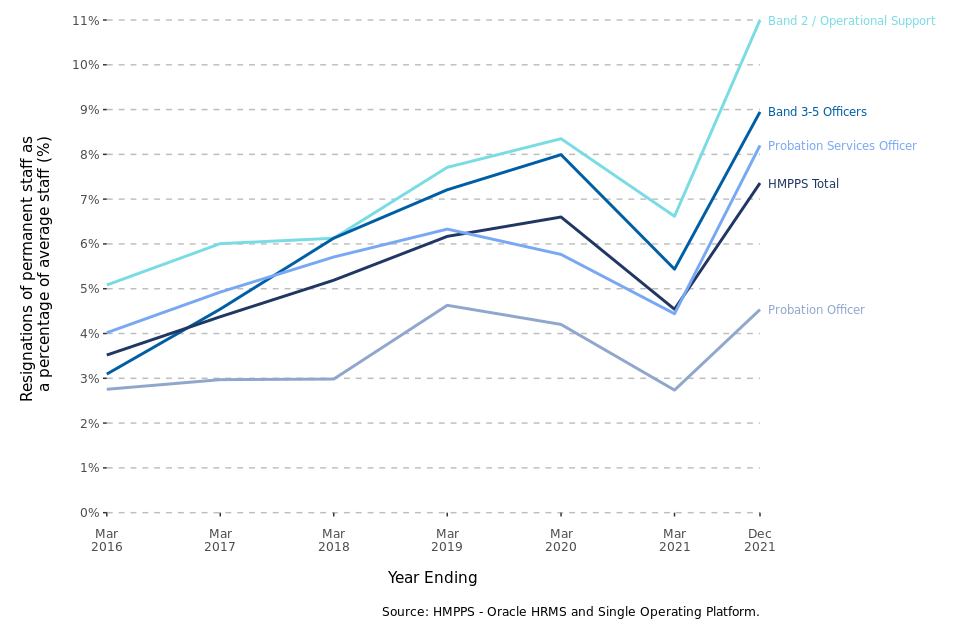
5. Sickness absence
HMPPS staff lost an average of 13.0 working days to sickness absence in the 12 months ending 31 December 2021 (including COVID sickness)
This represents an increase of 1.7 average working days lost (AWDL) compared to the year ending 31 March 2021. It should be noted that since June 2021, these data now include COVID-19 related sickness data. Previously published figures were revised with our June 2021 release to include COVID-19 related sickness data.
Since June 2021 these sickness absence figures include COVID-19 AWDL sickness numbers, including a revision to all AWDL figures since the start of the pandemic. In addition, please see the annex with experimental statistics on COVID-19 and HMPPS staff, which includes information about staff absent due to COVID on given days.
In the year ending 31 December 2021, HMPPS staff lost an average of 13.0 working days to sickness absence. This is an increase from 11.4 average working days lost for the year ending 31 March 2021, but an increase of over 2.8 days compared to the predominantly COVID-free year ending 31 March 2020.
YCS staff had the highest sickness absence rate at 17.4 AWDL, followed by PSP (14.4 AWDL), PS (11.5 AWDL), and HQ and Area Services (7.2 AWDL) (Figure 7). Compared to the year ending 31 March 2021, these represent an increase of 2.5 days for YCS, an increase of 1.6 days for PSP, an increase of 3.0 days for PS, and an increase of 0.8 days for HQ and Area Services staff.
In the year to 31 March 2021, AWDL increased for PSP, HQ and Area Services staff, stayed the same for YCS, but dropped by over 2 days for Probation Services staff.
Figure 7: Average working days lost to sickness absence, 12 months to 31 March 2016 to 12 months to 31 December 2021 (Source: Table 18)
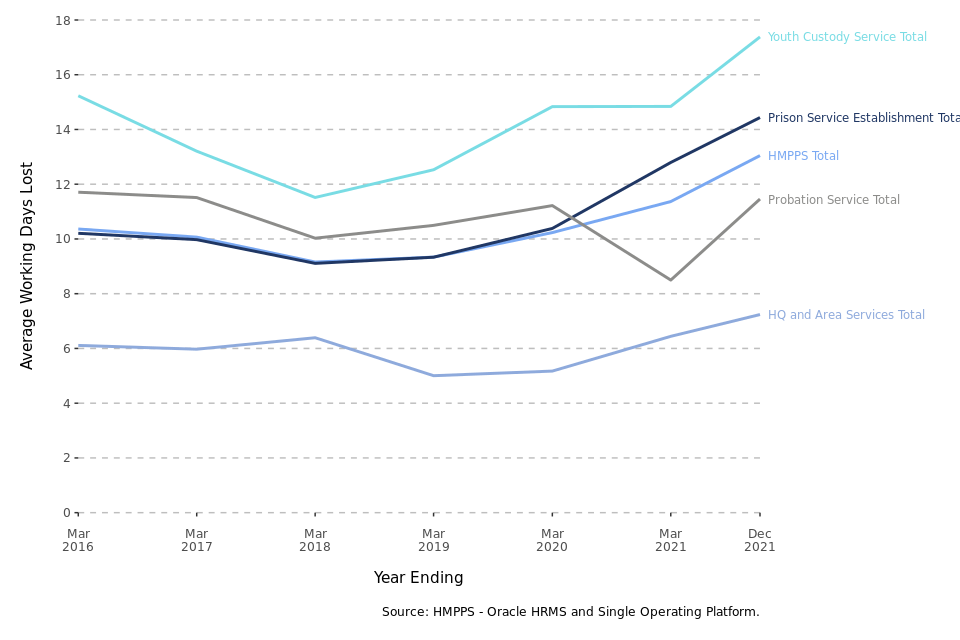
The most common category of sickness absence in terms of days lost was mental and behavioural disorders , corresponding to 29.6% of absences in the past year. This category was most prevalent for probation officers, where 49.1% of working days lost were attributed to mental and behavioural disorders.
For HMPPS overall the category that accounted for the second largest proportion of working days lost was epidemic/pandemic (23.9%). Together the top two categories accounted for 53.4% of all working days lost.
Further Information
Accompanying files
As well as this bulletin, the following products are published as part of this release:
-
A technical guide providing details of the HMPPS workforce structure as well as how the data are collected and processed. Information on the revisions policy and disclosure relevant to HMPPS staffing data is also included.
-
A set of summary tables for the latest quarter and year as well as over time.
-
A set of experimental statistics on the gender, ethnicity and disability status of recruitment campaign applicants for selected HMPPS Grades.
-
A supplementary annex presenting experimental statistics on Probation Officers in post, their required staffing level, and the number of trainee and qualified Probation Officers.
-
A supplementary annex on the effect of the coronavirus (COVID-19) on HMPPS staff. They are experimental statistics and include information about covid related testing, sickness and deaths of HMPPS staff.
Official statistics
The statistics in this bulletin are classified as official statistics. The Statistics and Registration Service Act 2007 defines ‘official statistics’ as all those statistical outputs produced by the UK Statistics Authority’s executive office (the Office for National Statistics), by central Government departments and agencies, by the devolved administrations in Northern Ireland, Scotland, and Wales, and by other Crown bodies (over 200 bodies in total). The statistics in this bulletin comply with all aspects of the Code of Practice for Official Statistics. The Code encourages and supports producers of statistics to maintain their independence and to ensure adequate resourcing for statistical production. It helps producers and users of statistics by setting out the necessary principles and practices to produce statistics that are trustworthy, high quality and of public value.
Experimental Statistics
The statistics in the Recruitment annex, Probation Officer annex and the annex on the effect of the coronavirus (COVID-19) on HMPPS staff are experimental statistics. Experimental statistics are a subset of newly developed or innovative official statistics undergoing evaluation. They are developed under the guidance of the Head of Profession for Statistics (HoP) and published to involve users and stakeholders in the assessment of their suitability and quality at an early stage. Therefore, we would like to receive feedback as to how useful they are, whether a different analysis would be preferable, or any other comments about them. If you wish to send any views you may have about these experimental statistics, please use the contact details below.
Contact
Press enquiries should be directed to the Ministry of Justice press office:
Tel: 020 3334 3536
Email: newsdesk@justice.gov.uk
Other enquiries about these statistics should be directed to:
Chris Casanovas
Corporate Data Sharing Lead
Data and Evidence as a Service
Ministry of Justice
10 South Colonnade
London
E14 4PH
Email: PPRWS_Correspondence@justice.gov.uk
Next update: 19 May 2022
URL: www.gov.uk/government/collections/national-offender-management-service-workforce-statistics
© Crown copyright
Produced by the Ministry of Justice
Alternative formats are available on request from statistics.enquiries@justice.gov.uk
-
This includes staff in Probation Service grades working in other parts of HMPPS. ↩
-
Percentage of staff with a permanent contract of employment who left HMPPS, including individuals who have retired early, but excluding staff who left due to voluntary early departure schemes and redundancy (VEDSR). ↩
-
Percentage of staff with a permanent contract of employment who resigned from HMPPS. ↩
